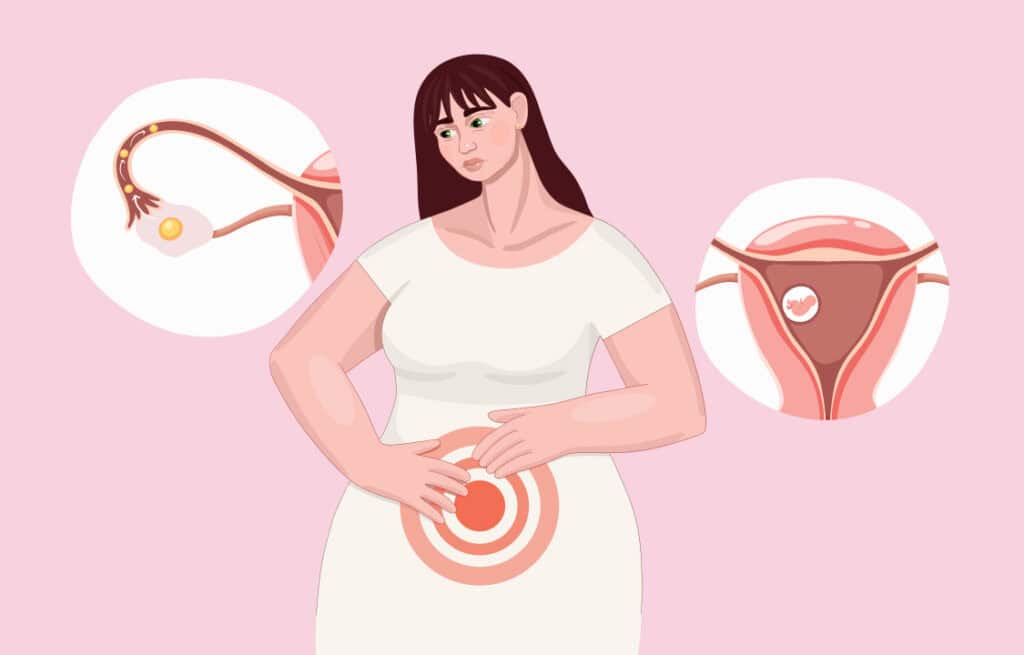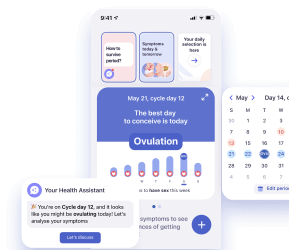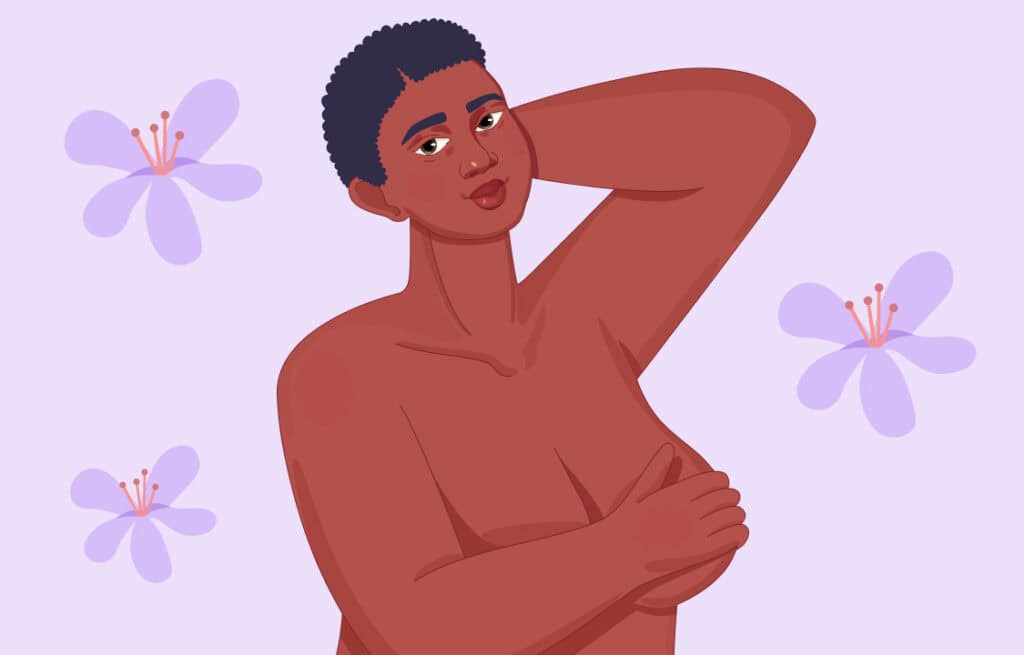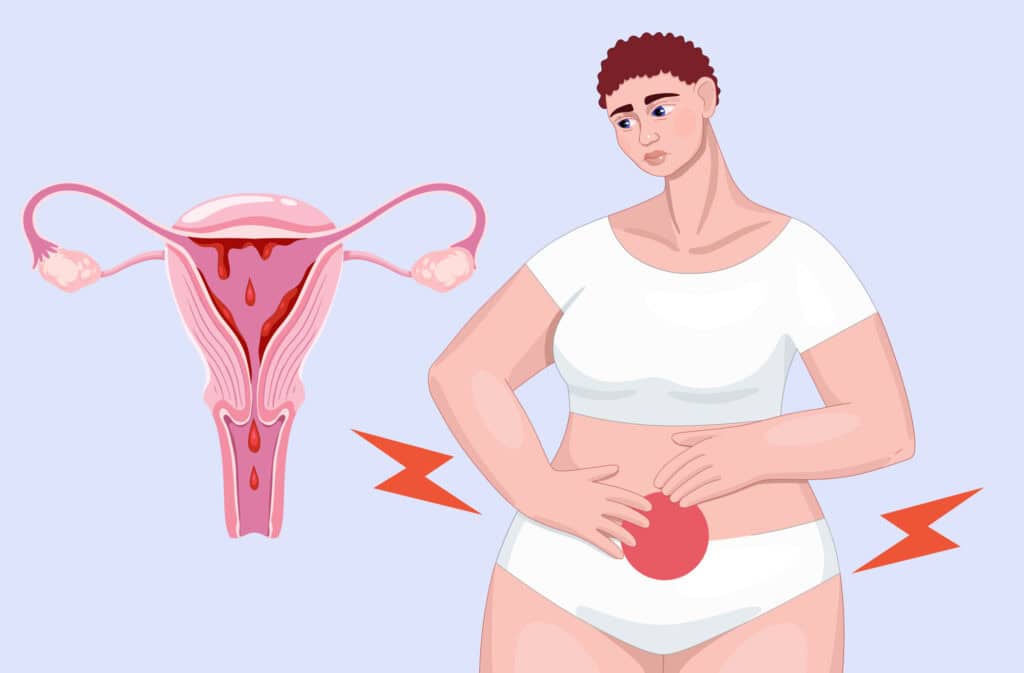Femia > Health Library > Getting Pregnant > Trying to conceive > Ovulation cramps vs implantation cramps: How to spot the key differences in pain, bleeding, and timing
Ovulation cramps vs implantation cramps: How to spot the key differences in pain, bleeding, and timing

- Updated Feb 27, 2025
- Published
CRAFTED BY HUMAN
Crafted by human At Femia, we provide accurate and up-to-date information at every stage of your journey, from trying to conceive, pregnancy and postnatal support. All content is created by a real person based on in-depth research and own professional experience. Femia ensures that you will receive expert advice, strict accuracy and a personalized approach from our authors/medical experts. Learn more about our editorial policy.
FACT CHECKED
Fact checked At Femia Health, we maintain the highest standards of editorial excellence in delivering content focused on helping you conceive, guiding you through pregnancy, and supporting you postpartum. Explore our content review principles to learn how we ensure the accuracy and quality of our health and lifestyle tips for every stage of your journey.
Ovulation vs implantation cramps mostly differ in timing, location, and sensation. Ovulation cramps happen around the middle of the menstrual cycle and pain is usually located on one side of the lower abdomen. Implantation cramps appear later (6–12 days after ovulation) with a central ache in the lower abdomen. Although bleeding and spotting may be similar, ovulation causes light pink spotting and implantation may vary in color from brown to light pink.
As you try to conceive, implantation cramps may be the earliest signs of pregnancy. With an average menstrual cycle of 28 days, the first day is when you start bleeding. Ovulation often happens on day 14, and some women may experience slight discomfort in their lower abdomen and spotting.
Implantation happens after an egg is fertilized and attached to the uterine lining – that’s when some may bleed a little and get implantation cramps. Although causing similar discomfort as menstruation and ovulation, implantation pain usually lasts for no longer than two days.
Understanding how your body works when you try to get pregnant and how to differentiate ovulation vs implantation cramps will play a crucial role in how easy it would be for you to conceive. So, let’s get to the details.

What is ovulation and implantation?
Ovulation is a day when your body releases an egg so it can be fertilized by sperm when having timely intercourse.
As you may have already guessed, this is your most fertile time. There is a term known as the “fertility window,” and it includes the five days before ovulation and the ovulation day. So, this is the best time to have sex if your goal is to conceive.
Implantation, therefore, comes a bit later. Once you ovulate and a sperm fertilizes an egg, it travels down to the uterus, where it will attach to the uterine lining. And this is the moment when pregnancy begins.
So, the key difference between ovulation bleeding and implantation bleeding is timing.
👉Find out more: How long after sex does implantation occur: Understanding the timeline
Ovulation cramps vs implantation cramps: Key differences
Location of cramps
| Ovulation | Implantation |
|---|---|
| Cramps often occur on one side of the lower abdomen. That is because ovaries release an egg from one of the ovaries, so pain tends to be located on only one side during each cycle. | Cramps may be felt more centrally in the lower abdomen or pelvis, as they are associated with the fertilized egg embedding itself into the uterine lining. |
Intensity of cramps
| Ovulation | Implantation |
|---|---|
| Those cramps are usually mild to moderate in intensity. However, some women may experience sharper twinges, and intensity will vary from cycle to cycle. | Generally, implantation cramps are mild and subtler than ovulation cramps. They’re often described as a light, pulling or tugging sensation rather than a sharp pain. |
Duration of cramps
| Ovulation | Implantation |
|---|---|
| Craps may last from a few minutes to up to several days aligning with the release of an egg from the ovary. They’re usually short-lived, subsiding once ovulation is complete. | Those cramps often last 1–3 days, with the discomfort often being more consistent but still mild. They can happen around 6–12 days after ovulation, closer to the time of a missed period. |
Timing differences: ovulation vs implantation
1. Ovulation
Your ovulation day will depend on the cycle length, but in general, it occurs around day 14 of an average 28-day menstrual cycle. During ovulation, an ovary releases a mature egg into the fallopian tube, where it’s available for fertilization by sperm.
2. Implantation
Implantation generally takes place 6-12 days after ovulation. So, considering that ovulation tends to happen around day 14, implantation may occur between days 20-26. If it happens, the fertilized egg (at this time called a blastocyst) travels down the fallopian tube toward the uterus. It then implants into the uterine lining, where it will begin to develop into an embryo.
@femia.fertility If you're not sure what your symptom means, you can always ask Femia ❤️ #ttc #ttccommunity #implantation #implantationprocess #dreambaby #implantationcramps ♬ original sound - Femia fertility app
Ovulation pain vs implantation pain: What to expect
When it comes to understanding pain associated with ovulation vs implantation, there are some distinct differences in both intensity and location, although some overlap can lead to confusion. Let’s quickly go through the differences for a better understanding:
Ovulation pain
Ovulation pain, sometimes called Mittelschmerz (a German word meaning “middle pain”), will vary in intensity, ranging from a dull ache to a sharp, sudden pain that can even make you bend.
Usually felt on one side of the lower abdomen, the pain corresponds with the ovary releasing an egg. The side may vary from cycle to cycle, depending on which ovary is ovulating.
Ovulation pain typically lasts a few minutes to a few hours, although in some cases, it may linger for a day or two. The aches are often described as a “stabbing” or “twinging” sensation, Mittelschmerz can sometimes be accompanied by mild cramping or a sense of fullness in the abdomen.
Implantation pain
Implantation pain is often milder and described as a light cramping or pulling sensation, whereas ovulation is sharper. The pain is generally centralized in the lower abdomen.
Implantation pain is brief, so it may last from a few minutes to a couple of days – but most often it’s only one day. Most women don’t even notice any changes or mistake the pain for minor premenstrual cramping. Implantation pain is usually more subtle, feeling like a gentle, dull ache or mild pressure.
Difference between ovulation bleeding vs implantation bleeding
Another factor that can help differentiate ovulation vs implantation cramps is bleeding. The consistency, duration, and color of the bleeding play a crucial role in:
- Ovulation: light pink bleeding mixed with egg white cervical mucus;
- Implantation: pink, brown, or light red bleeding mixed with more watery cervical mucus.
Ovulation spotting vs implantation spotting: Understanding the color and flow
If you are trying to differentiate ovulation spotting vs implantation spotting, focus on timing, color, and flow as three important clues. Here is what to consider:
Color and consistency of ovulation spotting
Ovulation spotting occurs in the middle of the menstrual cycle when the ovaries release an egg. The spotting might be clear, light pink, or red and may have a slight mucus-like consistency. In most cases, there is no noticeable ovulation spotting, or it’s minimal and lasts just a day or two.
👉Find out more: How long after implantation bleeding can I test for pregnancy?
Color and flow of implantation spotting
Implantation spotting happens later, about 6-12 days after ovulation, when a fertilized egg attaches to the uterine lining. Spotting is lighter in both color and flow than ovulation spotting. It may appear as a light pink or brownish discharge, and the flow is so minimal that many people only notice it when wiping.

Questions from the Femia community
Can ovulation cramps last longer than a day?
Yes, ovulation cramps may last from a few minutes to several days, depending on individual factors.
Can you have both ovulation and implantation cramps in the same cycle?
The short answer is yes. Ovulation occurs first and implantation later – all within one menstrual cycle.
Is implantation bleeding always a sign of pregnancy?
While implantation bleeding can indicate pregnancy, not all women experience it, and other factors may cause light bleeding.
Can ovulation pain feel like period cramps?
Ovulation pain, for some, feels like period cramps, but it's usually less intense and localized to one side of the abdomen.
The bottom line
Knowing the differences between ovulation vs implantation cramps is essential for anyone trying to track fertility or early pregnancy signs. Ovulation cramps occur mid-cycle and are usually short-lived, affecting only one side of the lower abdomen as an egg is released. In contrast, implantation cramps, which happen closer to the next period, are more centrally located and subtler in intensity, often accompanied by light spotting.
Differentiating between ovulation spotting and implantation bleeding can be helpful: ovulation spotting tends to be clear or light pink and minimal, while implantation bleeding is lighter, typically pink or brown, and brief. Knowing these signs can help you better monitor your cycles and potentially recognize early pregnancy cues. Consultation with a healthcare provider is advisable if there’s uncertainty.
References
- Cleveland Clinic. “Ovulation: Calculating, Timeline, Pain & Other Symptoms.” Cleveland Clinic, 7 Aug. 2022, my.clevelandclinic.org/health/articles/23439-ovulation.
- “Implantation (Embryology).” Wikipedia, 17 Oct. 2022, en.wikipedia.org/wiki/Implantation_(embryology).
- Cleveland Clinic. “Conception.” Cleveland Clinic, 9 June 2022, my.clevelandclinic.org/health/articles/11585-conception.
- “Ovulation Pain: Symptoms, Causes & Pain Relief.” Cleveland Clinic, my.clevelandclinic.org/health/diseases/9134-ovulation-pain-mittelschmerz.
- https://www.facebook.com/verywell. “What Are Implantation Cramps?” Verywell Health, 2021, www.verywellhealth.com/implantation-cramps-5203920. Accessed 10 Oct. 2024.
- “Understanding Ovulation Bleeding.” Clearblue, 20 June 2023, www.clearblue.com/ovulation/understanding-ovulation-bleeding. Accessed 10 Oct. 2024.
- “Implantation Bleeding: Causes, Symptoms & What to Expect.” Cleveland Clinic, my.clevelandclinic.org/health/symptoms/24536-implantation-bleeding.

Learn the signs that indicate your breast milk is coming in during pregnancy. Discover when lactation starts, what changes to expect, and how to manage leaking breast milk.

Learn the crucial differences between period vs miscarriage bleeding. Understand symptoms, timing, and how to distinguish early miscarriage vs period. Expert guidance from Femia.

Want to achieve a better orgasm? Explore our best techniques and methods to give a try solo and with your partner.

